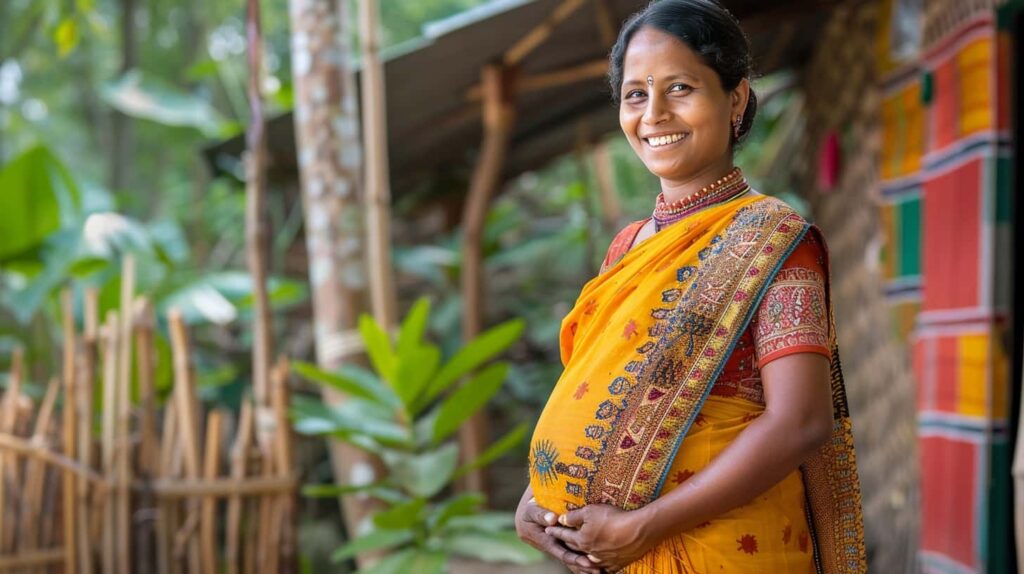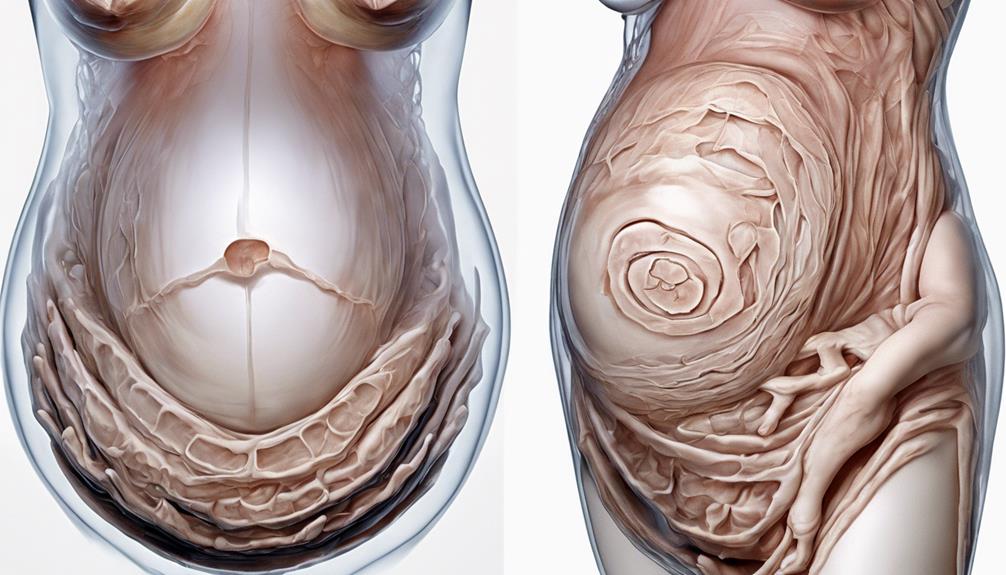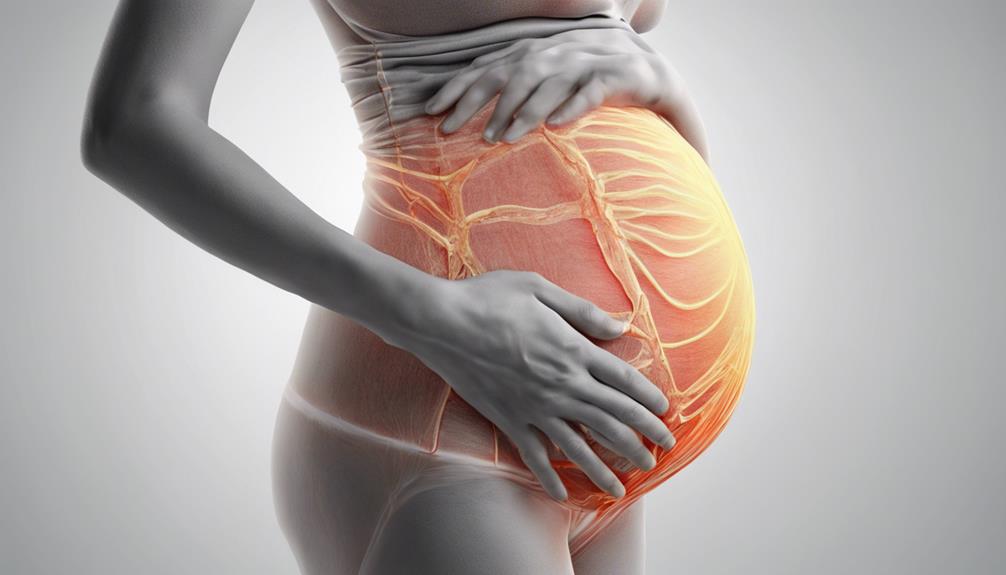Embarking on the journey of pregnancy milestones, figuring out the exact moment when the second trimester starts can seem as elusive as chasing shadows. But fear not, because in this text, there is a beacon of knowledge that will guide you through the twists and turns of trimester changes.
Curious about the subtle nuances that mark this pivotal shift in your pregnancy journey? Let’s unravel the mystery together, shedding light on the telltale signs that herald the dawn of the second trimester.
Key Takeaways
- The second trimester begins at week 13 and ends at week 26.
- It marks rapid fetal development and increased energy levels.
- Baby’s organs mature, and noticeable changes in the mother’s body occur.
- Emotional changes, baby’s growth milestones, and reduced pregnancy symptoms are key features.
Definition of Second Trimester
In pregnancy, the second trimester is defined as the period starting around week 13 and extending until week 26, marked by significant growth and development for both the mother and the baby.
During these weeks, fetal development progresses rapidly as the baby’s organs mature, laying down the foundation for a healthy life. As the baby bump becomes more pronounced, the mother may notice a surge in energy levels, a welcome reprieve from the fatigue of the first trimester.

Pregnancy symptoms like nausea and morning sickness often diminish, allowing many women to enjoy this stage more comfortably. However, it’s important to attend regular prenatal check-ups to monitor the mother’s and baby’s health closely. These visits are important in ensuring maternal well-being and promptly addressing any concerns.
The second trimester is a time of great change and growth, both physically and emotionally, for expectant parents.
Physical Changes in Second Trimester

Entering the second trimester, notable physical changes become more pronounced as the uterus grows, exerting pressure on surrounding organs and causing discomfort for expectant mothers. Here are some key transformations you may experience during this stage:
- Skin Stretching: The expansion of your belly can lead to skin stretching, potentially causing itching and the appearance of stretch marks.
- Increase in Blood Volume: Your body increases its blood volume to support the baby’s growth and development, ensuring an adequate blood supply for both of you.
- Weight Gain: The expected weight gain in the second trimester is mainly attributed to the growing baby, increased blood volume, and other physical changes.
- Breast Enlargement and Belly Growth: Physical changes like breast enlargement and a noticeable increase in belly size are common occurrences during the second trimester, reflecting the progression of your pregnancy.
These changes are natural and signify the beautiful journey of pregnancy, although they may bring some discomfort and adjustments. Embracing these transformations with care and understanding is essential for your well-being during this special time.
Emotional Changes During Second Trimester
During the second trimester of pregnancy, expectant mothers may experience a wide range of emotional changes, from excitement over feeling the baby move to occasional worries about childbirth and parenting. It’s common to have a mix of emotions during this stage, including anxiety, low mood, and moments of joy.
While some anxiety is normal, persistent feelings of anxiety or low mood could be signs of antenatal depression, and seeking help from healthcare professionals or support hotlines is essential. The emotional journey in the second trimester involves bonding with the baby through feeling their movements and attending scans, which can be both exciting and nerve-wracking.
Addressing common worries and concerns that arise during this period is crucial for emotional well-being. Support from midwives, partners, family, or professionals can play an important role in helping expectant mothers cope with emotional changes and maintain a sense of balance and positivity throughout the second trimester.
Baby’s Development in Second Trimester

Bonding with the baby through feeling their movements and attending scans, expectant mothers witness significant milestones in their baby’s development during the second trimester, such as the onset of organ functionality and the emergence of noticeable movements around week 19. As the baby grows, here are some key points to ponder****:
- Fetal Growth: The baby’s size in the second trimester can vary from about 7.5cm and 30g to 23cm and 820g, showing a remarkable increase in size and weight.
- Organs Functioning: Crucial organs like the liver, pancreas, and kidneys begin to function during this trimester, laying the foundation for the baby’s overall health.
- Baby’s Movements: Around week 19, mothers can start feeling the baby’s movements, a heartwarming experience that strengthens the bond between mother and child.
- Ultrasounds and Weight: Regular ultrasounds help track the baby’s growth and development milestones, with the baby potentially weighing around 2 pounds by the end of the second trimester.
These developments signify the baby’s growth and well-being, bringing joy and anticipation to the expectant parents.
Transition Signs to Second Trimester
Upon entering into the second trimester of pregnancy, expectant mothers often experience a notable reduction in symptoms like nausea and fatigue. This shift marks a turning point in the pregnancy journey, bringing about an increase in energy levels and a decrease in early pregnancy symptoms.
As the second trimester progresses, baby bump growth becomes more evident, and mothers may start feeling fetal movements, adding to the excitement of carrying new life. Symptoms such as morning sickness tend to diminish, offering a sense of relief and a break from the challenges faced in the first trimester.
Week 13 is a significant milestone as it signifies the official start of the second trimester, accompanied by these positive changes that signal a new phase in the pregnancy. Below is a table summarizing the shift signs expectant mothers may experience when moving into the second trimester.
| Shift Signs | Description |
|---|---|
| Reduced Nausea | Decrease in feelings of nausea and queasiness |
| Fatigue | Less tiredness and increased energy levels |
| Baby Bump Growth | Noticeable increase in the size of the belly |
Frequently Asked Questions
What to Expect When Does Second Trimester Start?
When does the second trimester start? Around week 13, symptoms like nausea and fatigue often decrease. The baby bump shows, and feelings of fetal movement begin. It’s a time for a growing belly, reduced discomfort, and connecting with baby’s movements.
When Am I Officially in My Second Trimester?
We’re officially in our second trimester at week 13 of pregnancy. That’s when things start feeling a bit more stable and energetic. It’s like stepping into the sunshine after a cloudy morning – a brighter phase begins.
How Do I Know My Pregnancy Is Going Well in Second Trimester?
Our pregnancy is going well in the second trimester by regular prenatal visits, feeling baby movements, monitoring growth through ultrasounds, improvement in symptoms, a balanced diet, hydration, and safe exercises. All these factors assure a healthy progression.
What Is Most Important During Second Trimester?
During the second trimester, the most important focus is on monitoring fetal growth, organ development, and overall health. Regular antenatal visits, ultrasounds, and seeking advice from healthcare professionals are essential for ensuring a healthy pregnancy.
Conclusion
In summary, the second trimester is a vital period in pregnancy, marked by significant physical and emotional changes for both the mother and the baby.
While some discomforts may arise, regular prenatal care and monitoring are essential to make sure a healthy pregnancy.
Despite any challenges, the second trimester is a time of growth and development, both for the baby and the expectant mother, leading towards the exciting journey of welcoming a new life into the world.










